 |
 |
 |
http://www.varalaaru.com A Monthly Web Magazine for South Asian History [187 Issues] [1839 Articles] |
 |
 |
 |
http://www.varalaaru.com A Monthly Web Magazine for South Asian History [187 Issues] [1839 Articles] |
|
Issue No. 93
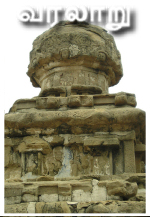
இதழ் 93 [ மார்ச் 2013 ] 
இந்த இதழில்.. In this Issue.. 
|
Series:
Pudukkottai Cave Temples
Thevarmalai lies in a remote place in Namanasamudram-Ponnamaravathi route. Next to Peraiyur a mud road cut towards north and one has to make two kilometers travel in the mud road to reach Thevarmalai. From the mud road in a few yards walk one can reach the embankment of a reservoir and in the end of the pathway a small canal cuts and crossing the canal we can reach the rock cut cave. Thevarmalai might be the name of the hillock or the region which forms the name of the rock cut shrine. The rock cut shrine is situated in a tranquil setup with trees, paddy fields and a small canal surrounding it.1 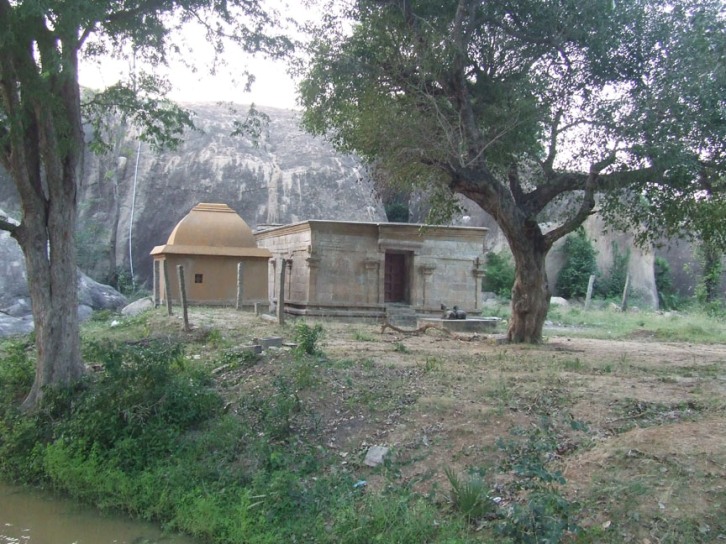 THE TRANQUIL SETUP IN WHICH THE ROCK CUT SHRINE LIE The hillock in which the rock-cut cave is scooped is huge and stretches 0.07kms in northeast and southwest directions to a width of 0.03kms.2 Apart from it few rock boulders also found scattered around it. The rock cut cave is scooped on the northern end of the hillock in its lower echelon facing east. In the open space in front of the shrine under the shady trees a platform with two nandis are seen. The shrine consists of a sanctum with a rock cut extension and a later constructed structural mandapa in the front. The structural addition has a padabandha adhishthana, pilasters sectioning the wall on three sides and a flat roof. The walls of the structural addition end adjoining the mother rock on both the sides. A flight of eight steps arranged on the eastern side of the structural addition leads to the inner part of the mandapa. It is a pillared hall with balitala and nandi in the center facing the sanctum. Goddess standing on a platform is seen on the north side of the mandapa. 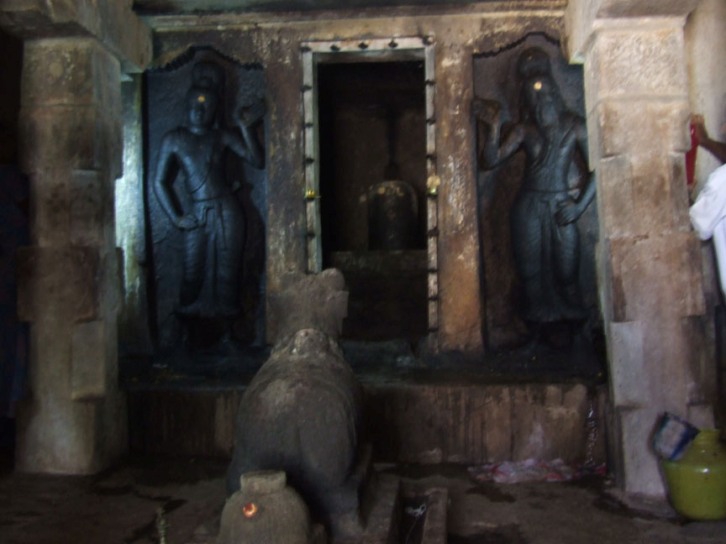 THE ROCK CUT CAVE WITH THE DOOR ADORERS The rock cut extension consists of side walls, floor and roof in front of the shrine cell. The floor of the rock cut extension is 0.35mts above the mandapa floor level and extended to 0.57mts and 2.98mts in the east-west and north-south directions respectively. The height of the fascia between the roof and the floor of the rock cut extension is 1.88 mts.3 The anterior wall of the rock cut shrine is sectioned by four pilasters. The aperture to the shrine cell is cut in the middle and the space between the pilasters on either side is formed as niches to house the bas relief sculptures. The pilasters are plain brahmakanta shaft. The potikas which rests on the pilasters are angular taranga with single limbs extending inside the niches, forming it vaulted. The limbs of the potikas bear the uttira above. The vajana buffers the roof and the uttira. The rough rock cut brow extends equally to the level of the rock cut floor measuring 0.62mts, forming a kapota to the shrine cell. The canopy of the extended roof is flat and well formed. The pilasters, the sill and the niches in the anterior wall of the sanctum are formed to a height of 0.05mts from the rock cut floor extension. The niche in the south is 1.69mts height, 0.70mts breadth and 0.13mts depth, whereas on the north 1.71mts height, 0.70mts breadth and 0.14mts depth. The door adorers housing the niches are rishis, known as Agathiyar and Pulathiyar.4 The middle two pilasters flank the entrance to the sanctum. The width of the opening is 0.64mts and the height is 1.60mts between the jambs. The shrine is a square cell measuring 2.65 mts in all directions. The height of the sanctum is 1.96 mts. The sanctum houses Lord Siva in the form of Linga. Both the avudaiyar and bana is formed out of mother rock. The avudaiyar is square and formed as padabandha basement.5 It is 1.23mts in north-south and 1.14mts in east-west directions. On both side of the rock cut shrine on the eastern precipice of the mother rock the bas-relief sculptures of Ganesa and a young male figure6 is cut inside the niches.7 The male figure adorns the northern niche whereas the southern niche houses Ganesa.8 The northern niche is 0.35mts high from the mandapa floor and it is 0.66mts width, 0.95mts height and to a depth of 0.25mts. The niche in the south is 0.91mts width, 0.32mts depth, 1.23mts height and is 0.29mts from the mandapa ground level. The water outlet for the sanctum is formed on the sill and on the northern niche. Within the vicinity of temple complex to the south of the rock cut temple is a small structural shrine facing west.9 The shrine houses a miniature Linga, Nandi and two saints said to be Sundarar and Perumilazhai Kurambar and called in the name of the latter. It is said to be the cemetery of the Perumilazhai Kurumbar.10 Only one inscription11 is found in Thevarmalai, engraved on the eastern precipice of the hillock, to the south of the rock cut cave and in front of the Perumilazhai Kurumbar shrine, popularly known as Udirappatti inscription.12 Though the inscription inscribed within the vicinity of the temple complex it didn't speak about the deity or the temple.13 The rishi in the south is younger comparing his counterpart in the north. Both are standing on the floor of the niche slightly parting their legs and their feet are in tryasra. The floor of the northern niche is much worn-out. Both the rishis are leaning their upper body towards outer side but their head inclined towards the sanctum. Both are eulogizing14 the deity on their inner hand and the outer hand of the rishi in the north is on his thigh whereas to his counterpart in the south is in katyavalampita. Both are wearing silk dress draping upto their calf region and shown with heavy crease. The bottom tip of the apparel is gathered at the centre and tucked under the hip belt. Similar fashion of dressing is also seen in the northern dvarapalas of Kundrandarkoil and Thirumeyyam Sathyagiriswara rock cut shrines.15 The girdle of the hip belt formed as a single bow in the centre and suspended in the front. Both their tresses are neatly arranged as a jatamakuta in the apex with loose locks floating behind.16 The rishi in the north is holding one of his tresses in his right hand which is also admiring the deity in the sanctum. Their ears are elongated without kundalas and a vastra is worn as yajnopavita in upavita fashion. Beard and mustache are shown for the rishi in the north to enhance his aged appearance, while it is absent for his counterpart. 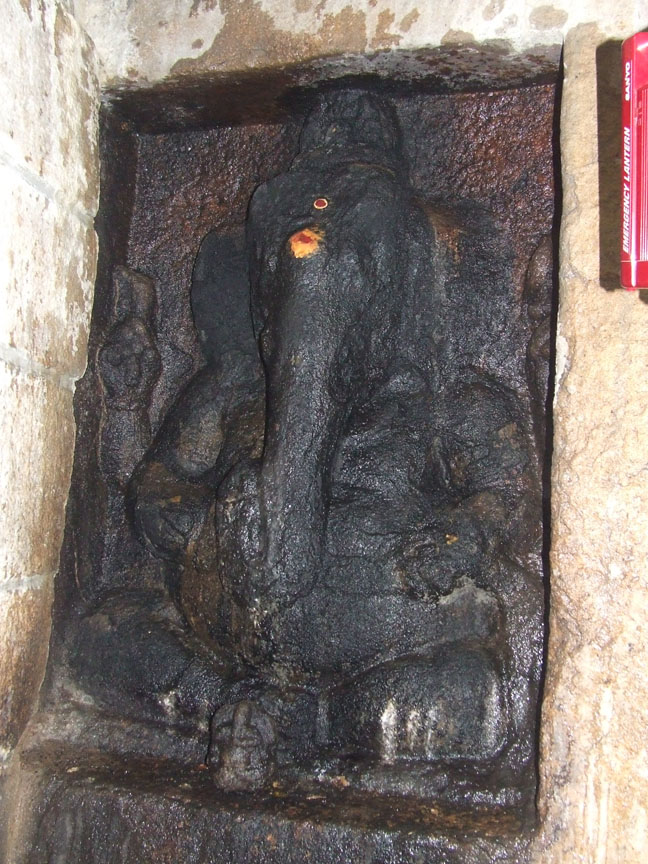 GANESA Ganesa on the southern niche is seated in folded legs on a platform17 formed inside the niche. The sculpture is much worn-out hence the features, ornaments and the objects carry by him are not clear. Forehead, makuta,18 front hands are partially worn-out, the back right hand is holding nilotpala and the left hand is holding sugarcane.19 The front right hand is worn-out and the corresponding left hand is holding the udarabandha that fastened around the waist.20 Bangles and armlets are the ornaments visible. The proboscis is right turned and holding a motaka. 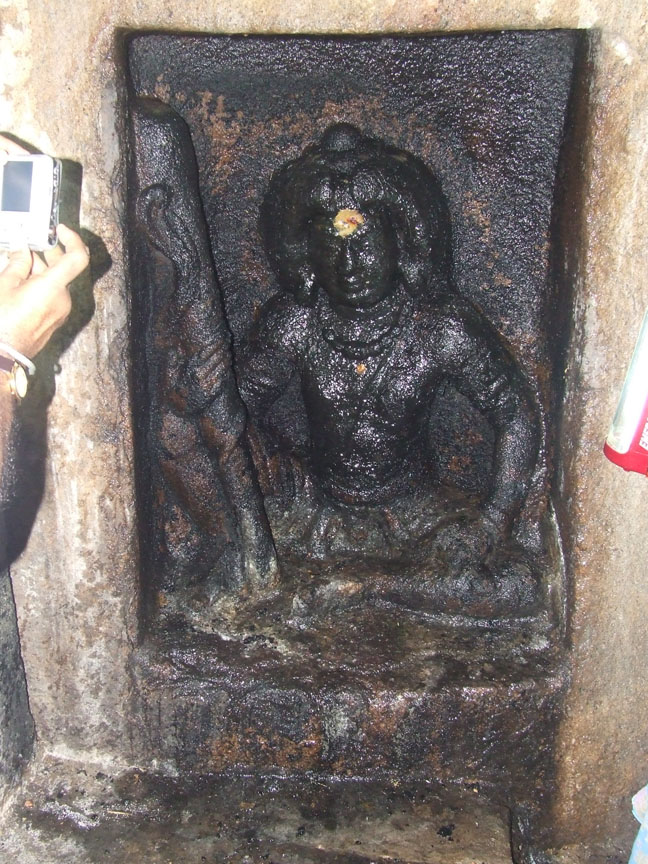 MALE FIGURE The male figure on the northern niche is seated on a spread in lalitasana21 with his left leg folded flat on the spread and the right leg folded upright. His hair is styled as jatabhara which is shown as a thick pad parted in the centre with a protuberance at the crest, might be a flower. His lower garment is draping up to knee and shown with heavy crease. It is fastened around the waist with the help of the hip belt and the girdle of the hip belt is formed as a bow in the centre and the excess girdle is held by the left hand resting on the lap. Bangles, coiled armlets, patrakundalas, beaded mala and udarabandha are the ornaments worn by him. Thin yajnopavita is worn in upavita fashion. The udarabandha is either beaded or with a clasp at the centre. The left hand is rested on the left of his lap holding the excess noose that flows from the waist belt and the right hand is holding a plain club. It is placed on the spread between the feet and held by his right hand in a cozy posture, slightly resting on the right leg. The club is heavy at the top and gradually thinning at the bottom in which a snake is twirling and its head is raised. The saint looks young, simple and virtuous. LAKULISA CONTROVERSY Lakulisa the founder of Pasupatha form of Saivism said to be the 28th incarnation of Siva, born at Kayavaroha in Bhrgukaccha or the modern Broach region. He is said to be the systamatizer of the Pasupata order. Among the four sects of Saivism, the Pasupata is the oldest and Gujarat was one of the most revered centres of this sect. Pasupata is also said to be the spiritual parent of the Kalamukhas which was prominent in the Karnataka region around medieval period. 'By the time of Harsa-vardhana and probably as early as Gupta times, there were Pasupata temples in most parts of India. Post-Gupta sculptures of Lakulisa have been found though-out India, although the centre of gravity for both sculpture and epigraphy shifts to the south by about the end of the 10th century A.D'.22 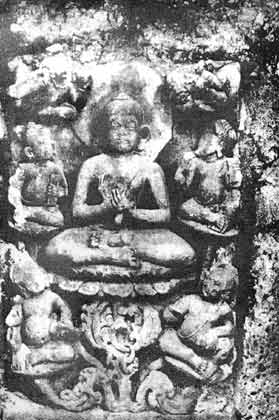 Lakulisa in Darmachakra-pravartana-mudra and his disciples According to G.Buhler, 'Lakulisa – the Lord (Isa) who bears a club (lakuda) – a plain club and not the katvanga, is the identifying mark of Lakulisa sculpture'. But according to D.R.Bhandarkar, he quotes a verse from a work called 'Visvakarma vatara-vastu-sastra' stated that the sculptures of Lakulisa should show him seated in the padmasana, with his penis erect, with a citron in his right hand and a danda (club) in his left. Most known sculptures depict him in this pose.23 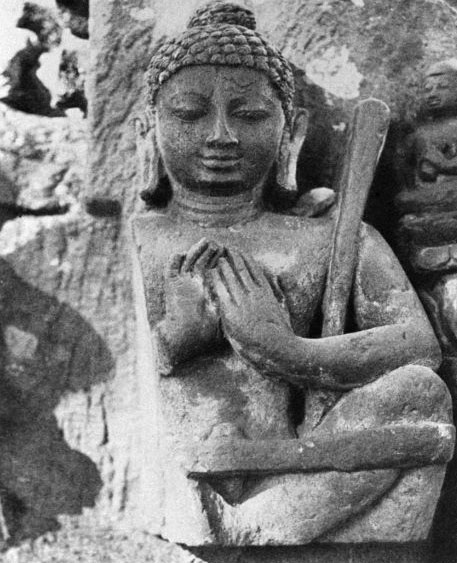 Lakulisa in Darmachakra-pravartana-mudra and Lakuda 'The icons of Lakulisa are in the yogic posture, seated with crossed legs (baddha-padmasana), he is shown as having a citrus fruit (matulunga) in his right hand and a short cudgel (lakuda) in his left. Some images show his membrum virile prominently. It was usual to show a linga at his back; but later images omit this detail. He was also represented as standing and holding a cudgel in one hand. Lakulisa was also shown as four-armed. An interesting icon from the Someswara temple at Mukha lingam, shows him seated like Buddha in the baddha padmasana posture, and his two normal hands joined in the dharma-chakra-mudra. He sits upon a double lotus (visvapadma). His upper right hand holds a rosary and the corresponding left hand carries a big trident. Tucked in on the left side is cudgel resting on his lap. The stalk of the double-lotus divides the pedestal panel into two halves, each half showing two sages seated in yoga-patta. The four figures are identified as the disciples of Lakulisa : Kausika, Maitreya, Gargya and Kaurushya, who spread the Pasupata cult'.24 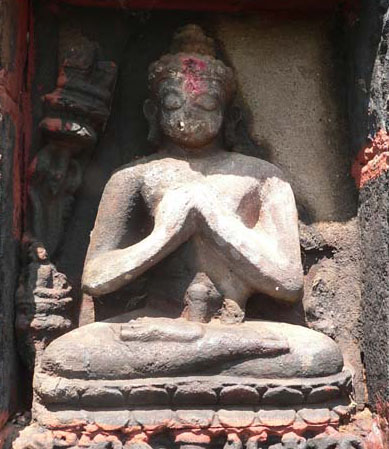 In a profile study made on the basis of pictures collected from internet belonging to various region and period, and also on the basis of the description made by the above said authors, it is understood that the sculptures of Lakulisa are depicted as seated in any one of the posture viz., padmasana, ardhapadmasana, suhasana, yogasana with yogapatta. In some cases standing postures are also seen. The seated postures are shown on a well bloomed lotus. He is either naked or shown in short attire, his hair mostly done of matted finishing and sometimes typical Buddha hair style i.e., closely cropped and ringlets. Mostly shown in two hands and some times four hands are also seen. The objects in the back hands are usually akshamala and sula. The front hands carry either pomegranate or akshamala or lakuda in one hand and the other hand rested on his thigh or otherwise both the hands in Darmachakra-pravartana-mudra with lakuda placed on his lap or simply darmachakra-pravarta-mudra. Usually the Lakuda is shown placed on the left his lap and resting on his left shoulder rarely held by his left hand, sometimes placed in the middle resting on his chest and shoulder. In some of the panels he is also depicted with his four disciples and in one of the bronze icon he is accompanied by Brahma and Vishnu. Thus the characteristic features of Lakulisa are lakuda, his seated posture, lotus seat, darmachakra-pravartana-mudra, erect penis, citron, hair dressing etc. 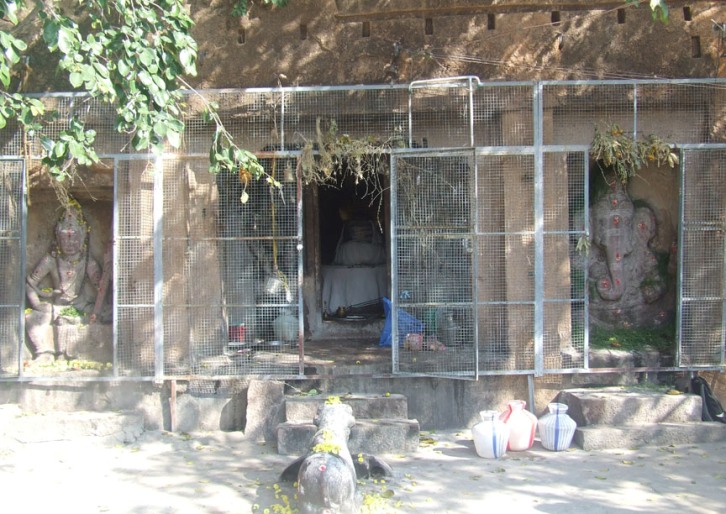 ARITTAPATTI ROCK CUT CAVE 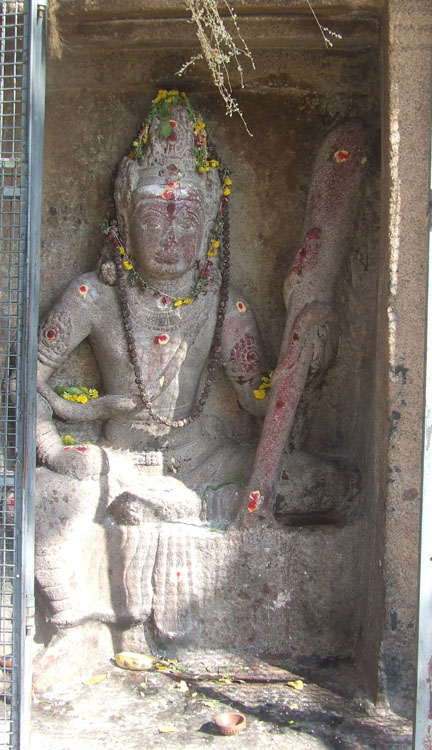 ARITTAPATTI MALE FIGURE The presence of the plain club at the hands of the Thevarmalai and Arittapatti male figures made to designate them as South Indian version of Lakulisa.25, 26 Besides being accepting them as Lakulisa, it is to accept that both the figures are not typically similar. Thevarmalai male is simple and austere; Arittapatti male is grand and majestic. The only commonness between them is the cudgel and their incidence of location. Hence accepting them as one and same is unconvincing. The Thevarmalai male figure is lacking the vital characteristic features of Lakulisa, atleast combination of one or two characteristic features are needed to designate him as Lakulisa. Hence on the basis of the above argument it can be concluded that the Thevarmalai male figure is not Lakulisa. Footnotes : 1. Field work on 05-02-10, 19-02-10, 14-08-10 2. www.earth.google.com, Latitude : 10021' 12.58N Longitude : 78044' 15.00E 3. சு.இராசவேல், அ.கி.சேஷாத்திரி, தமிழ்நாட்டுக் குடைவரைக் கோயில்கள், பண்பாட்டு வெளியீட்டகம், சென்னை, 2000. 'முகமண்டபப் பகுதியும் அர்த்த மண்டபப் பகுதியும் சற்றே உயரமாக அமைந்துள்ளன'. P.142, There is only one mandapa in front of the rock cut cave. 4. Such sculptures are also seen in Thirukolakkudi. 5. Components are upana, jagadi, rudra kumudha, kanda flanked by kambu on both sides, pattika and upari kambu. 6. There is controversy over this male figure, some scholars state it as Chandeswara and some as Lakulisa. Soundara Rajan, K.V., Rock cut Temple Styles : Early Pandyan Art and the Ellora Shrines, According to the author the figure in the northern niche is Lakulisa. P.93. அர.அகிலா, வரலாறு -3, தேவர்மலை, mentioned the sculpture as Chandeswara, P.58. மு.நளினி, இரா.கலைக்கோவன், தென்தமிழ்நாட்டு குடைவரை தொகுதி-4 புதுக்கோட்டை மாவட்ட குடைவரைகள், according to the authors the figure lacks certain characteristic features of Lakulisa and hence they deemed him as some esteemed person. P.139. Rajamohamed, J., ஆவணம் 19, "புதுக்கோட்டை மாவட்ட குடைவரைகள்" 2008 stated that the sculpture cannot be taken as Chandeswara due to the absence of mazhu or axe. P.167. 7. ibid., Soundara Rajan, K.V., 'on the outer wall of the sanctum are carved four panel sculptures respectively of Ganesa, Rsis on either side of the cella door and Lakulisa, in that order' P.92. But only the rishis are on the outer wall of the sanctum, whereas Ganesa and Lakulisa are on the mother rock on either side of the sanctum. 8. ibid., சு.இராசவேல் அ.கி.சேஷாத்திரி, In P.No.142 'பாறை சரிவின் தென் வட பகுதிகளைக் கோட்டங்களாக்கி விநாயகரையும் சண்டேஸ்வரரையும் சிற்பங்களாக சமைத்துள்ளனர்'. P.No.143 'பக்கப்பாறைப் பகுதிகளில் அமைந்துள்ள கோட்டங்களில் தென்புறம் விநாயகரும் இடப்புறம் சண்டேஸ்வரரும் காணப்படுகின்றனர்'. But in P.No.144 'வடபுறக் கோட்டத்தில் இலகுலிசத் தொடர்புடைய சிற்பம் காணப்படுகிறது'. Contradiction in their own statement for same sculpture. 9. ibid., சு.இராசவேல் அ.கி.சேஷாத்திரி, "இக்குடைவரைக் கோயில் வளாகத்தின் பின்புறத்தே மேற்கு நோக்கிய திருவாயிலுடன் பிற்காலத்திருப்பணியாக சிறியதொரு மண்டபப்பகுதி அமைந்துள்ளது". P.No.143. But the shrine of Perumilazhai Kurumbar is not behind the temple complex it is within the temple complex, to the south of the rock cut shrine. 10. ibid., அர.அகிலா, P.60. சு.இராசவேல், அ.கி.சேஷாத்திரி P.142. மு.நளினி, இரா.கலைக்கோவன், P.141-142. 11. IPS No.927. 12. Udirappatti means solatium or compensation given to the family of the person who committed sacrifice or murdered or committed suicide on false accusation. Two other such inscriptions mentioning Udirappatti are found at rock cut temple complexes in the Pudukkottai district viz., Kudumiyanmalai and Thirumeyyam. 13. The inscription dated 11th day of the month Avani, Thunmugi year, details about the compensation of a plot and 3ma of land by the Malayalangudi village assembly to one lady named Nadiyar due to the suicide committed by one Maluva Kumarappar by consuming poison. The relationship between Nadiyar and Maluva Kumarappar cannot be understood as much of its portion is worn-out. The place Malayalangudi is mentioned as 'padaiparru', i.e. a military station. 14. ibid., Soundara Rajan, K.V., The description of inner hand as vismaya mudra is wrong. P.93. 15. Srinivasan, K.R., Temples of South India, National Book Trust, India, 1972, according to the author, one of the dvarapala flanking the shrine entrance of Thirumeyyam, Kundrandarkoil and Thevarmalai, a portrait sculpture of a king or chieftain, also found at Veerasigamani. P.57. 16. ibid., Soundara Rajan, K.V., according to the author their hair style signify them as Pasupatha yogis of North India. P.92. 17. ibid., சு.இராசவேல் அ.கி.சேஷாத்திரி, 'தென்புறக் கோட்டத்தில் அரைத்தாமரை மீது அமர்ந்தவாறு நான்கு கைகளுடன் காட்டப்பட்டுள்ள பிள்ளையாரின் திருவுருவம்' P.143-144. The deity is not seated in a lotus. 18. ibid., Soundara Rajan, K.V., according to the author it is karandamakuta. P.93. Ibid., மு.நளினி, இரா.கலைக்கோவன், சிறுமகுடம். P.138. 19. ibid., K.V.Soundara Rajan, K.V., upper hands are holding parasu and pasa. Ibid., மு.நளினி, இரா.கலைக்கோவன், 'வலப்பின் கையில் இருப்பது சிறு தடி அல்லது நீலோத்பலமாகலாம்'. P.138. 20. ibid., Soundara Rajan, K.V., 'the front right hand is carrying mathulanga and the corresponding left hand holds motaka. The right hand is much worn-out and the object in the hand is not clear'. But the front left hand is holding the udarabandha which also flow beyond his hand. P.93. 21. ibid., Soundara Rajan, K.V., maharaja lilasana stated by the author is wrong. P.93. 22. Lorenzen David N., Kapalikas and Kalamukhas : Two Lost Saivite Sects, University of California Press, Berkeley and Los Angeles, California, 1972. P.185 23. ibid., P.188 24. Ramachandra Rao, S.K., Prathima-Kosha, Encyclopaedia of Indian Iconography, Vol. six, Kalpatharu Research Academy, 1992, P.42. 25. ibid., Soundara Rajan, K.V., “This, together with the example at Arittapatti shows variant forms in the south of the usual upper Indian and Karnataka-Andhra Lakulisas which show the characteristic urdhva-medhra and are not to be deemed as a dvarapala figure but of Lakulisa”. P.93. 26. ibid., Soundara Rajan, K.V., according to author the shrine had been excavated under Pandya patronage, “As evidence by Lakulisa panel sculpture itself, by the nature of the dress and Rsi figures as dvarapalas or worshippers - seen elsewhere at Virasikamani, Tirukattalai and correspondingly in Kerela at Kaviyur cave temple - the form of Linga in the sanctum and the right turned trunk of Ganesa figure in this cave”. P.92. this is txt file� |

சிறப்பிதழ்கள் Special Issues 

புகைப்படத் தொகுப்பு Photo Gallery 
|
| (C) 2004, varalaaru.com. All articles are copyrighted to respective authors. Unauthorized reproduction of any article, image or audio/video contents published here, without the prior approval of the authors or varalaaru.com are strictly prohibited. | ||